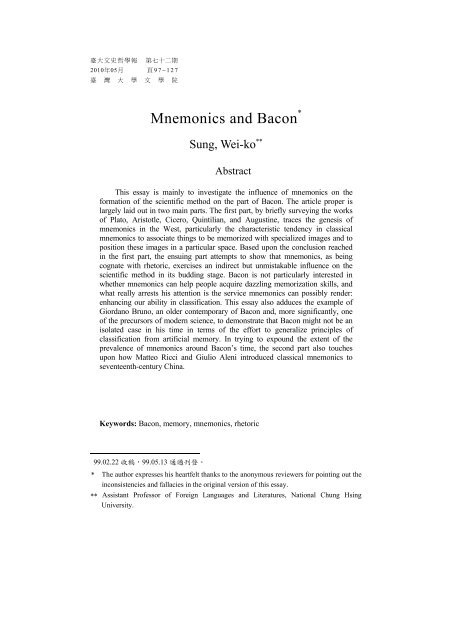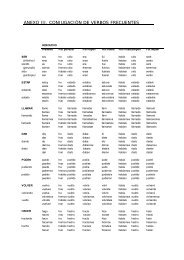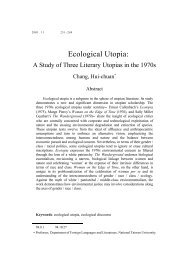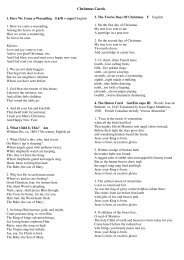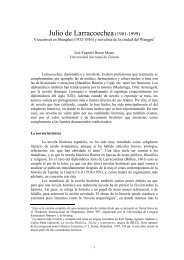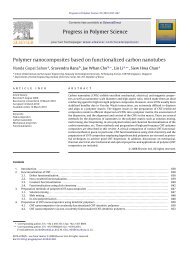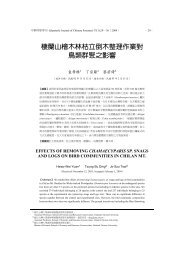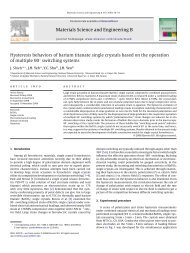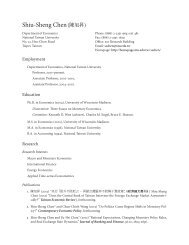Mnemonics and Bacon
Mnemonics and Bacon
Mnemonics and Bacon
Create successful ePaper yourself
Turn your PDF publications into a flip-book with our unique Google optimized e-Paper software.
臺大文史哲學報 第七十二期<br />
2010年05月 頁97~127<br />
臺 灣 大 學 文 學 院<br />
<strong>Mnemonics</strong> <strong>and</strong> <strong>Bacon</strong> ∗<br />
Sung, Wei-ko ∗∗<br />
Abstract<br />
This essay is mainly to investigate the influence of mnemonics on the<br />
formation of the scientific method on the part of <strong>Bacon</strong>. The article proper is<br />
largely laid out in two main parts. The first part, by briefly surveying the works<br />
of Plato, Aristotle, Cicero, Quintilian, <strong>and</strong> Augustine, traces the genesis of<br />
mnemonics in the West, particularly the characteristic tendency in classical<br />
mnemonics to associate things to be memorized with specialized images <strong>and</strong> to<br />
position these images in a particular space. Based upon the conclusion reached<br />
in the first part, the ensuing part attempts to show that mnemonics, as being<br />
cognate with rhetoric, exercises an indirect but unmistakable influence on the<br />
scientific method in its budding stage. <strong>Bacon</strong> is not particularly interested in<br />
whether mnemonics can help people acquire dazzling memorization skills, <strong>and</strong><br />
what really arrests his attention is the service mnemonics can possibly render:<br />
enhancing our ability in classification. This essay also adduces the example of<br />
Giordano Bruno, an older contemporary of <strong>Bacon</strong> <strong>and</strong>, more significantly, one<br />
of the precursors of modern science, to demonstrate that <strong>Bacon</strong> might not be an<br />
isolated case in his time in terms of the effort to generalize principles of<br />
classification from artificial memory. In trying to expound the extent of the<br />
prevalence of mnemonics around <strong>Bacon</strong>’s time, the second part also touches<br />
upon how Matteo Ricci <strong>and</strong> Giulio Aleni introduced classical mnemonics to<br />
seventeenth-century China.<br />
Keywords: <strong>Bacon</strong>, memory, mnemonics, rhetoric<br />
99.02.22 收稿,99.05.13 通過刊登。<br />
∗ The author expresses his heartfelt thanks to the anonymous reviewers for pointing out the<br />
inconsistencies <strong>and</strong> fallacies in the original version of this essay.<br />
∗∗ Assistant Professor of Foreign Languages <strong>and</strong> Literatures, National Chung Hsing<br />
University.
98<br />
臺 大 文 史 哲 學 報<br />
1. A Brief Overview of Classical <strong>Mnemonics</strong><br />
This essay aims first to provide an overview of memory in the history of ideas<br />
<strong>and</strong>, thence, deals with how mnemonics helps mold <strong>Bacon</strong>’s scientific method. In an<br />
age that has witnessed many great strides in human technology of storing up<br />
information, it is difficult, if not impossible, for modern readers to envision that<br />
mnemonics played a significant role in Western civilization before the advent of<br />
printing. Indeed, the intertwining between memory <strong>and</strong> rhetoric dates back to<br />
ancient Greece. Mnemosyne, the goddess of memory <strong>and</strong> remembrance, represents<br />
“the necessary rote memorization to preserve history <strong>and</strong> sagas” before the invention<br />
of writing, <strong>and</strong> is accordingly depicted as the mother of the Muses. 1 What arrests<br />
our further attention is that in Greek mythology Mnemosyne is also represented as<br />
the inventor of language <strong>and</strong> words. 2 For example, in Plato’s Critias, Critias says<br />
that “But besides the gods <strong>and</strong> goddesses whom you have mentioned, I would<br />
specially invoke Mnemosyne; for all the important part of my discourse is dependent<br />
on her favour, <strong>and</strong> if I can recollect <strong>and</strong> recite enough of what was said by the priests<br />
<strong>and</strong> brought hither by Solon, I doubt not that I shall satisfy the requirements of this<br />
theatre” (529). 3<br />
1 I learned of this source from http://www.theoi.com/Titan/TitanisMnemosyne.html.<br />
2 Ibid.<br />
3 Caplan devotes a useful discussion of Mnemosyne’s varied profiles in ancient Greek<br />
literature. According to Caplan, the earliest characterization of Mnemosyne as the mother<br />
of the Muses dates back to Hesiod’s Theogany, wherein Mnemosyne is portrayed as the<br />
daughter of Earth <strong>and</strong> Heaven (Caplan 200). In his study of the making <strong>and</strong> recitation of<br />
epic, Chen similarly mentions the importance of “Mnēmosunē” for Homer (38); that is, in<br />
invoking the Muse, the poet entreats for, besides inspiration, a tenacious memory as well<br />
to recite his creation (103). In the Homeric Hymn to Hermes, the son of Maia “honors<br />
Mnemosyne in his song first among all the gods” (Caplan 200). For several other<br />
Greco-Roman deities associated with memory, see Caplan, p. 200. It should be further<br />
noted that the term “Homeric” should not mislead us to think that these Homeric hymns<br />
are composed by the creator of Iliad <strong>and</strong> Odyssey. The earliest reference to the Homeric<br />
hymns comes from Thucydides, who ascribes these hymns to Homer. These hymns are<br />
“Homeric” in that they share the same epic meter (dactylic hexameter), dialect, <strong>and</strong> style<br />
with Iliad <strong>and</strong> Odyssey (Rayor 1). These poems are “hymns” because they are devotional<br />
songs sung in honor of gods, “usually at a contest held as part of a religious festival or of<br />
some other solemn occasion” (Athanassakis xiv). Today the authorship of these Homeric<br />
Hymns remains a moot question. Interested readers can see Athanassakis, pp. xiii-xvii,<br />
<strong>and</strong> Rayor, pp. 1-13.
<strong>Mnemonics</strong> <strong>and</strong> <strong>Bacon</strong><br />
(1). Simonides, Cicero, Quintilian, <strong>and</strong> Rhetorica ad Herennium<br />
Another link between memory <strong>and</strong> rhetoric in Greek mythology can be found<br />
in the story of Simonides. 4 A nobleman from Thessaly named Scopas, the winner of<br />
a boxing contest, one day holds a banquet, <strong>and</strong> as one of the invited guests<br />
Simonides is commissioned to compose a panegyric in honor of the host. Because a<br />
portion of this poem digresses to eulogize Zeus’ illegitimate twin sons, Castor <strong>and</strong><br />
Pollux, the miserly host grumbles to Simonides that he will pay only half of the<br />
honorarium agreed on beforeh<strong>and</strong>, <strong>and</strong> that Simonides can ask for the remainder<br />
from the twins. Later someone comes into the banquet hall <strong>and</strong> informs the poet that<br />
two young men waiting outside would like to meet him. However, when Simonides<br />
leaves the banquet <strong>and</strong> steps outside the hall, he cannot spot anyone. At the instant<br />
Simonides steps outside, the roof of the banquet hall collapses <strong>and</strong> crushes the host,<br />
as well as all the other guests, to death. All the corpses are horrendously mangled,<br />
but Simonides remembers the seat arrangement of every single guest so that he can<br />
faultlessly relate it to those who intend to collect their relatives’ dead bodies.<br />
It is, however, worth our attention that the aforementioned story of Simonides<br />
as the inventor of mnemonics is not preserved in any extant Greek manuscripts, but<br />
set down by Cicero in his De Oratore (Yates 18). 5 According to Yates, Cicero relates<br />
this story to discuss memory as one of the five elements of rhetoric <strong>and</strong> to describe<br />
the mnemonics of “places” <strong>and</strong> images adopted by Roman orators (18). Another two<br />
classical treatments of mnemonics—Rhetorica ad Herennium (Rhetoric for<br />
Herennius) <strong>and</strong> Quintilian’s Institutio Oratoria—are at once treatises on rhetoric. 6<br />
4 Simonides (6th century-5th century, B.C.E.), whose birth <strong>and</strong> death cannot be accurately<br />
dated, is a Greek poet whose poetry is no longer extant except for some fragments<br />
allegedly authored by him. Plutarch ascribes the aphorism “painting is silent poetry <strong>and</strong><br />
poetry painting that speaks,” which inspires Lessing’s Laocoön, to Simonides (The<br />
Oxford Classical Dictionary 1409).<br />
5 In addition to Cicero, Quintilian several others have their own accounts of the story about<br />
Simonides as the inventor of mnemonics. Cicero’s <strong>and</strong> Quintilian’s versions are the most<br />
complete ones. There are, however, some discrepancies over the name of the winner of<br />
the boxing contest, <strong>and</strong> it is interesting to note that the divine twins, Castor <strong>and</strong> Pollux,<br />
are also famous for their pugilistic skills (Small 276). It is Yates’ pioneering The Art of<br />
Memory that engages my interest in the history of mnemonics. I am also greatly inspired<br />
by Rossi’s excellent treatment of the vicissitudes of the art of memory before <strong>and</strong> in<br />
<strong>Bacon</strong>’s time in his Logic <strong>and</strong> the Art of Memory: The Quest for a Universal Language.<br />
6 Rhetoric for Herennius, the earliest extant work on all the five aspects of rhetoric, had<br />
been considered Cicero’s work through the Middle Ages (Kennedy 121). It is Jerome, the<br />
foremost contributor to the formation of the Vulgate Bible, who ascribes the authorship of<br />
99
100<br />
臺 大 文 史 哲 學 報<br />
Since the Greek sources Rhetorica ad Herennium draws on, which per se are<br />
treatises on rhetoric, are all lost, the historical uniqueness of Rhetorica ad<br />
Herennium speaks for itself (Kennedy 123; Yates 21). This unknown author of<br />
Rhetorica ad Herennium, following Aristotle, suggests that an ideal orator possess<br />
the following elements: inventio, dispositio, elocutio, memoria, <strong>and</strong> pronuntiatio.<br />
And in mnemonics what matters the most is locus <strong>and</strong> images, <strong>and</strong> a locus is “a<br />
place easily grasped by the memory, such as a house, an intercolumnar space, a<br />
corner, an arch, or the like. Images are forms, marks or simulacra of what we wish to<br />
remember” (Yates 22). 7<br />
It should also be noted that the role of memory in rhetoric is not restricted to<br />
the fivefold scheme mentioned in the preceding paragraph. The connection between<br />
memory <strong>and</strong> rhetoric can be investigated from other angles. The author of Rhetorica<br />
ad Herennium, for example, contends that memory occupies a significant role in the<br />
tripartite definition of wisdom (prudentia). Wisdom, it states, is tantamount to<br />
“intelligence capable… by a certain judicious method, of distinguishing good <strong>and</strong><br />
bad” (III. ii; 162). A parallel idea can be found in De Inventione, where Cicero<br />
defines wisdom as the caliber to distinguish the good from the bad (II. lii; 327). And<br />
the essential elements of wisdom are memory, intelligence, <strong>and</strong> foresight; memory,<br />
suggests Cicero, is “the faculty by which the mind recalls what has happened” (II. lii;<br />
327). 8 Yates indicates that Cicero’s definition of wisdom in De Inventione serves as<br />
a significant precursor in molding what later becomes known as “the four cardinal<br />
virtues.” 9 When elaborating on the four cardinal virtues, both Albertus Magnus <strong>and</strong><br />
Thomas Aquinas adduce Cicero’s definition of prudence, <strong>and</strong>, more importantly, it is<br />
the prestige associated with the name “Cicero” that rivets medieval scholars’<br />
attention to the art of memory (Yates 20).<br />
(2). Plato, Aristotle, <strong>and</strong> Wax Tablet<br />
Rhetoric for Herennius to Cicero (Wilkins 51). Now the authorship of Rhetoric for<br />
Herennius remains an inconclusive question. For useful discussions, see Kennedy, pp.<br />
121-26, <strong>and</strong> Wilkins, pp. 51-56.<br />
7 In addition to locus <strong>and</strong> images, architecture is also closely connected with mnemonics.<br />
For the connection between architecture <strong>and</strong> mnemonics, see Mary Carruthers’ excellent<br />
treatment in The Craft of Thought: Meditation, Rhetoric, <strong>and</strong> the Making of Images,<br />
400-1200 (Cambridge: Cambridge UP, 1998), pp. 7-24.<br />
8 Whereas intelligence is the faculty “by which it [the mind] ascertains what is,” foresight<br />
is the faculty “by which it is seen that something is going to occur before it occurs” (De<br />
Inventione II, lii; 327).<br />
9 The four cardinal virtues are prudence, justice, fortitude, <strong>and</strong> temperance.
<strong>Mnemonics</strong> <strong>and</strong> <strong>Bacon</strong><br />
One recurrent metaphor can be spotted in all the three Latin works introduced<br />
in the preceding section: All liken the inner pressing of images on memory to the<br />
markings on a wax tablet. The possible reason for this analogy is twofold. First, this<br />
metaphor attests to the prevalence of wax tablet as a writing device in ancient times.<br />
Second, this metaphor is indicative of an inherent link between ancient mnemonics<br />
<strong>and</strong> contemporary theories of memory (Yates 50). The metaphor of wax tablet can<br />
be traced back to Plato’s Theaetetus. In conversing with Theaetetus, Socrates says:<br />
“I would have you imagine, then, that there exists in the mind of man a block of wax,<br />
which is of different sizes in different men; harder, moister, <strong>and</strong> having more or less<br />
of purity in one than another, <strong>and</strong> in some of an intermediate quality” (254). This<br />
tablet, adds Socrates, is a gift of Memory [sic], the mother of the Muses:<br />
When we wish to remember anything which we have seen, or heard, or<br />
thought in our own minds, we hold the wax to the perceptions <strong>and</strong><br />
thoughts, <strong>and</strong> in that material receive the impression of them as from the<br />
seal of a ring; <strong>and</strong> that we remember <strong>and</strong> know the image lasts; but when<br />
the image is effaced, or cannot be taken, then we forget <strong>and</strong> do not know.<br />
(Theaetetus 255)<br />
From a tripartite conversation among Cebes, Simmias, <strong>and</strong> Socrates in Phaedo,<br />
we are told one of Socrates’ favorite precepts: Knowledge is simply recollection<br />
(213). Though Socrates defines recollection as “a process of recovering that which<br />
has been already forgotten through time <strong>and</strong> inattention” <strong>and</strong> makes no mention of<br />
the term “association,” he suggests that recollection generally refers to one’s ability<br />
to derive the underst<strong>and</strong>ing of someone or something from some other person or<br />
something else (214). That is, even though the term “mnemonics” might never cross<br />
Socrates’ mind, the preliminary techniques of mnemonics have already been<br />
prefigured by Socrates. For example, Socrates finds out that people might remember<br />
their lovers at the sight of the lyres belonging to their beloved: “Do not they, from<br />
knowing the lyre, form in the mind’s eye an image of the youth to whom the lyre<br />
belongs?” (214)<br />
The advent of writing, for Socrates, will blunt our memory. The intertwining<br />
between writing <strong>and</strong> memory is reminiscent of a notable episode in Phaedrus, where<br />
Socrates <strong>and</strong> Phaedrus trade ideas about the essence of writing <strong>and</strong> its detrimental<br />
effect on the faculty of memory. 10 In Phaedrus, the young Phaedrus, an enthusiastic<br />
10 Anyone with a certain familiarity with Derrida’s works will not fail to recognize the<br />
importance of this story in Derrida’s speculation on the dialectical relation between<br />
speech <strong>and</strong> writing. See Derrida, “The Filial Inscription: Theuth, Hermes, Thoth, Nabû,<br />
Nebo” <strong>and</strong> “The Pharmakon,” in Dissemination (Chicago: U of Chicago P, 1981), pp.<br />
101
102<br />
臺 大 文 史 哲 學 報<br />
admirer of the famed rhetorician of that time, Lycias, intends to recite a speech of<br />
Lycias to Socrates. What is interesting is that while Phaedrus has readied himself for<br />
reciting Lycias’ speech to Socrates from memory, Socrates, glimpsing a roll under<br />
Phaedrus’ cloak, insists that Phaedrus “read” the speech verbatim since he has a<br />
manuscript at h<strong>and</strong>: “Much as I love you, I would not have you suppose that I am<br />
going to have your memory exercised at my expense.” To which Phaedrus responds,<br />
“Enough; I see that I have no hope of practicing my art upon you” (433). This<br />
passage is significant in that even though Phaedrus feels a little sullen over being<br />
prevented from showcasing his memory (his art), before long he still reverts to his<br />
art in his dialogue with Socrates.<br />
Whilst the whole dialogue between Phaedrus <strong>and</strong> Socrates is generally centered<br />
upon the essence of love, near its end the conversation digresses into a discussion on<br />
writing. Socrates tells Phaedrus that in Egypt there was an old man named Theuth,<br />
who was noted for his wisdom <strong>and</strong> was the purported inventor of many arts such as<br />
arithmetic, calculation, geometry, astronomy, draughts, dice, <strong>and</strong>, most importantly,<br />
the use of letters. At that time the king of Egypt was the god Thamus, <strong>and</strong> he tried to<br />
appraise each invention when Theuth presented the inventions to him. When they<br />
finally came to the letters, Theuth claimed that these letters could make the Egyptian<br />
people wiser <strong>and</strong> enhance their memories. Thamus, however, thought otherwise:<br />
“For this discovery of yours will create forgetfulness in the learners’ souls, because<br />
they will not use their memories; they will trust to the external written characters<br />
<strong>and</strong> not remember of themselves . . . they will be hearers of many things <strong>and</strong> will<br />
have learned nothing; they will appear to be omniscient <strong>and</strong> will generally know<br />
nothing” (Phaedrus 484). These qualms about writing are not a unique case. At least<br />
a similar resonance can be heard in Emerson though the target of complaint is not<br />
altogether identical. In an essay entitled “On Memory” Emerson writes: “Plato<br />
deplores writing as a barbarous invention which would weaken the memory by<br />
disuse…. If writing weakens the memory, we may say as much <strong>and</strong> more of printing.<br />
What is the newspaper but a sponge or invention for oblivion?” (99)<br />
With only slight variations, the metaphor of wax tablet can also be found in<br />
Aristotle. In De Memoria et Recollection (On Memory), Aristotle contends that the<br />
way experience leaves an image in our memory is not unlike that people “make an<br />
impression with a seal” (450 a 31-32). Thus, memory, writes Aristotle, does not occur<br />
in those “who are strongly moved owing to passion, or time of life, no memory is<br />
formed; just as no impression would be formed if the movement of the seal were to<br />
impinge on running water” (450 b 1-3). Similarly, Aristotle obviously believes that the<br />
84-94, pp. 95-117.
<strong>Mnemonics</strong> <strong>and</strong> <strong>Bacon</strong><br />
“imprint” nature of memory can help explain why the memory of infants <strong>and</strong> of the<br />
aged either teeters or falters because they are in “a state of flux, the former [infants]<br />
because of their growth, the latter [the aged], owing to their decay” (450 b 7-8).<br />
Aristotle continues his argument <strong>and</strong> comes up with the conclusion: “both those who<br />
are too quick <strong>and</strong> those who are too slow have bad memories. The former are too<br />
moist, the latter too hard, so that in the case of the former the image does not remain<br />
in the soul, while on the latter it is not imprinted at all” (450 b 8-11). The author of<br />
Rhetorica ad Herennium also mentions wax tablets when elucidating the concept of<br />
“backgrounds”: “For the images, like letters, are effaced when we make no use of<br />
them, but the backgrounds, like wax tablets, should abide” (III. xviii; 211).<br />
Carruthers, however, alerts us that the image of wax tablet is by no means<br />
uniquely Greco-Roman, since it can also be found in, for example, Proverbs: 11 “Let<br />
not loyalty <strong>and</strong> faithfulness forsake you; bind them about your neck, write them on<br />
the tablet of your heart” (3:3). Both Carruthers <strong>and</strong> Draaisma point out that the sway<br />
of this array of interrelated images, such as “imprinting,” “write upon,” or “wax<br />
tablets,” could still be keenly felt long after the wax tablet had given way to codex<br />
<strong>and</strong> other writing materials. For example, while investigating the nature of light <strong>and</strong><br />
how the human eyes receive light, Thomas Aquinas writes: “Aristotle finds an apt<br />
example of this in the imprint of a seal on wax. The disposition of the wax to the<br />
image is not the same as that of the iron or gold to the image; hence wax, he says,<br />
takes a sign, i.e. a shape or image, of what is gold or bronze, but not precisely as [sic]<br />
gold or bronze” (172). 12<br />
Actually, the notion of memory as an integral ingredient of wisdom dissected in<br />
the previous section is no less salient in Aristotle. For example, for Aristotle a good<br />
memory, together with other elements such as good parts, receptiveness, quickness<br />
of intuition, is conducive to excellence in virtue (1362 b 23-24). In De Memoria et<br />
Recollection, Aristotle reminds us of the essential correlation between memory <strong>and</strong><br />
imagination: “It is apparent, then, to which part of the soul memory belongs, namely<br />
the same part as that to which imagination belongs. And it is the objects of<br />
imagination that are remembered in their own right, whereas things that are not<br />
grasped without imagination are remembered in virtue of an incidental association”<br />
(450 a 22-23). Sorabji’s gloss on this passage runs as follows: “in its own right (kath’<br />
11 Carruthers notes that the trace of Greek influence on Proverbs is easily recognizable (29).<br />
12 As for the metaphor of memory as the apparatus to record words in the soul, Caplan<br />
enumerates more examples, which include passages excerpted from Aeschylus (“The<br />
unforgetting tablets of thy mind”); Shakespeare (“the table of my memory”); Longfellow<br />
(“leaves of memory”). See Caplan, pp. 213-14.<br />
103
104<br />
臺 大 文 史 哲 學 報<br />
hauto), but in virtue of an incidental association” (79). In a more direct fashion<br />
Caplan explains the crux of this passage; Aristotle simply points out a fact that must<br />
be familiar to today’s readers: Things bearing necessary associations are more easily<br />
recollected (203). Furthermore, these laws of association, similarity, contrast, <strong>and</strong><br />
contiguity are at work not only in mnemonics but also in the theory of style, since<br />
these laws involve the use of simile, metaphor, <strong>and</strong> contrast (Caplan 204). For<br />
sophists such as Protagoras, Gorgias, or Hippias, memory had long been an<br />
important device to further their already dazzling skills of improvisation (Caplan<br />
206).<br />
More contemporary evidence for the pervasiveness of mnemonics in the<br />
ancient world can be adduced in Aristotle, who explicitly refers to artificial memory<br />
on different occasions in his corpus. Indeed, the best ancient reflection on the<br />
psychology of memory is contained in Aristotle’s works, especially De Memoria et<br />
Recollection <strong>and</strong> De Anima (On the Soul). 13 According to Aristotle, the states of<br />
mind run, in chronological order, as follows: perception, memory, experience, <strong>and</strong>,<br />
last, a principle of skill <strong>and</strong> of underst<strong>and</strong>ing (Posterior Analytics 100 a 4-8). 14<br />
Similarly, in Topics Aristotle advises that concerning those questions of most<br />
frequent occurrence people should always be ready to put them into memory: “For<br />
just as in a person with a trained memory, a memory of things themselves is<br />
immediately caused by the mere mention of their ‘places,’ so these habits too will<br />
make a man readier in reasoning, because he has his premises classified before his<br />
mind’s eye, each under its number” (163 b 28-31). In this sense, it is interesting to<br />
note the correlation between locus <strong>and</strong> topoi here because it is quite possible that the<br />
title of Aristotle’s Topics derives from the “places” in mnemonics (Yates 46). 15<br />
Yet it should be clarified that Aristotle begins his treatise on memory by<br />
differentiating memory (remembering) from reminiscing (recollecting). Memory,<br />
Aristotle avers, is essentially related to the past (De Memoria et Recollection<br />
449 b 14), since it makes no sense if one claims that he or she is remembering the<br />
present. On the other h<strong>and</strong>, recollecting is “neither the recovery nor the acquisition<br />
13 This judgment is rendered by Léon Robin: “All that was best in orthodox psychology [of<br />
memory] down to the end of the XIX century is contained, in sum, in a few pages of<br />
Aristotle” (301).<br />
14 Aristotle, in Posterior Analytics, defines perception as “a connate discriminatory<br />
capacity” (99 b 35). As for “a principle of skill <strong>and</strong> of underst<strong>and</strong>ing,” Aristotle’s<br />
definition is as follows: “Of skill if it deals with how things come about, of underst<strong>and</strong>ing<br />
if it deals with what is the case” (100 a 8-9).<br />
15 Both the Latin word locus <strong>and</strong> the Greek word topoi mean “place” in English.
<strong>Mnemonics</strong> <strong>and</strong> <strong>Bacon</strong><br />
of memory” (451 a 19-20). Couched in layman’s terms, recollection is a “being<br />
reminded” <strong>and</strong> involves “one thing putting us in mind of another” (Krell 13). In a<br />
word, for Aristotle, having a good memory cannot be equated with being good at<br />
recollecting: “For the persons who possess a retentive memory are not identical with<br />
those excel in power of recollection; indeed, as a rule, slow people have a better<br />
memory, whereas those who are quick-witted <strong>and</strong> clever are better at recollecting”<br />
(449 b 6-9). 16<br />
(3). Augustine<br />
St. Augustine in his Confessions expresses an unreserved accolade on the<br />
faculty of memory <strong>and</strong> makes a profound meditation on the mystery of memory. 17<br />
For example, in Book X Augustine writes: “Great is the power of memory,<br />
exceeding great, O my God—an inner chamber large <strong>and</strong> boundless! Who has<br />
plumbed its depths?... A great admiration rises upon me; astonishment seizes<br />
me….And men go forth to wonder at the heights of mountains, the huge waves of<br />
the sea, the broad flow of the rivers, the extent of the ocean, <strong>and</strong> the courses of the<br />
stars, <strong>and</strong> omit to wonder at themselves” (154). 18 Indeed, Augustine is captivated<br />
with one of his friend’s astonishing memory. Once Augustine asks this friend named<br />
Simplicius what the penultimate lines in each of Virgil’s works are, Simplicius,<br />
without the slightest hesitation, waltzes through this challenge (Augustine 1956:<br />
358). It is noteworthy that as in Cicero’s discussion of memory, Augustine,<br />
impressed with his friend’s bent for memorization, believes that locus <strong>and</strong> images<br />
play important roles in the functioning of memory: “And I enter the fields <strong>and</strong><br />
roomy chambers of memory, where are the treasures of countless images, imported<br />
16 A short but useful account of the nuance between remembering <strong>and</strong> recollecting in the<br />
light of Greek etymology is provided by Richard Sorabji, p. 35.<br />
17 In a very short article entitled “Memory <strong>and</strong> Confession”(〈記憶與懺悔〉)Sher-shiueh<br />
Li points out the interdependent relationship between memory <strong>and</strong> confession: But for<br />
memory, how can we capture the past in the flux of time? Conversely, people would feel<br />
conscience-stricken when they try to recall a regrettable past (376). It is worthwhile to<br />
note that though Li illustrates his argument mainly by the example of The Journey to the<br />
West (《西遊記》), he mentions Augustine’s Confessions at the outset of his article.<br />
18 Augustine’s wonderment at the infinite immensity of memory finds an echo in the<br />
writings of Giulio Aleni (艾儒略): 「聖奧斯定云,涉記乃浩大之淵,不知何等,<br />
乃有無涯容受。亦深窈,亦顯明,難以言語揣摹」(240). I owe an anonymous reviewer<br />
of an earlier version of this essay for the reference to Aleni’s works. An Italian Jesuit<br />
missionary, Giulio Aleni (1582-1649), following in Matteo Ricci’s (利瑪竇) footsteps,<br />
arrived in China in 1609 <strong>and</strong>, thence, embarked on his missionary work (Pan 6).<br />
105
106<br />
臺 大 文 史 哲 學 報<br />
into it from all manner of things by the senses” (Confessions 152-53). Lines later<br />
Augustine makes it clear that it is the images of things, not the things themselves,<br />
that are stored up in memory (153). Augustine goes further in claiming that many<br />
more branches of knowledge (literature <strong>and</strong> rhetoric included) are “taken from the<br />
memory”: “And yet are not these all that the illimitable capacity of my memory<br />
retains. Here also is all that is apprehended of the liberal sciences, <strong>and</strong> not yet<br />
forgotten—removed as it were into an inner place, which is not a place … For what<br />
is literature, what skill in disputation, whatsoever I know of all the many questions<br />
there are, is so in my memory” (154). What arrests our attention here is that what<br />
occurs to Augustine first, as far as memory is concerned, is literature <strong>and</strong> skill in<br />
disputation. That is, this quotation again displays the link between memory <strong>and</strong><br />
rhetoric.<br />
Despite Augustine’s exuberant reflection on memory, the essence of memory<br />
remains a recondite enigma to him. The mysterious essence of memory more eludes<br />
Augustine when he juxtaposes forgetfulness with memory in his attempt to elucidate<br />
memory: “I name memory, <strong>and</strong> I know what I name. But where do I know it<br />
[forgetfulness], except in the memory itself? Is it also present to itself by its images,<br />
<strong>and</strong> not by itself?” (Confessions 158). On the essence of forgetfulness, Augustine<br />
remarks that “But when I remember forgetfulness, there are present both memory<br />
<strong>and</strong> forgetfulness—memory, whereby I remember, forgetfulness, which I remember.<br />
But what is forgetfulness but the privation of memory? How, then, is that present for<br />
me to remember, since, when it is so, I cannot remember?” (159). Then Augustine<br />
reiterates his experience of being spellbound by the inscrutability of memory: “Great<br />
is the power of memory; very wonderful is it. O my God, a profound <strong>and</strong> infinite<br />
manifoldness” (160). 19<br />
2. <strong>Mnemonics</strong> <strong>and</strong> <strong>Bacon</strong><br />
For most modern readers, the prevalence of mnemonics before the advent of<br />
printing is imaginable. However, a question naturally rises: Could mnemonics retain<br />
its glory after printing made access to knowledge not only possible but also easy?<br />
That is, if people want to read anything they think of, they have easy access to<br />
whatever they want. Generally speaking, mnemonics has been gradually superseded<br />
<strong>and</strong> sidelined by printing since the fifteenth century. Though the decline of<br />
19 For a more detailed discussion of how Augustine conceptualizes memory in the empirical<br />
sense, see Gerald O’Daly’s Augustine’s Philosophy of Mind (Berkeley: U of California P,<br />
1987), pp. 131-51.
<strong>Mnemonics</strong> <strong>and</strong> <strong>Bacon</strong><br />
mnemonics had been an unstoppable tendency in the wake of the growing wide<br />
prevalence of printing, it played a constituent role in the formation of <strong>Bacon</strong>’s<br />
scientific method in the seventeenth century.<br />
(1). Ricci <strong>and</strong> Aleni<br />
Before we investigate <strong>Bacon</strong>’s own ideas of memory, a particular mention of<br />
Matteo Ricci’s works can give us a glimpse of the extent to which ancient, classical<br />
mnemonics still remained strong around the threshold of the seventeenth century.<br />
Though Italy <strong>and</strong> Engl<strong>and</strong> are geographically <strong>and</strong>, more crucially, religiously apart,<br />
the ensuing overview of Ricci’s art of memory will reveal that classical mnemonics<br />
proposed by Quintilian <strong>and</strong> in Rhetorica ad Herennium was then still a fundamental<br />
part of the st<strong>and</strong>ard curriculum in the Catholic world. Ricci arrived in China <strong>and</strong> fell<br />
to his missionary work in 1583. With an unusual caliber for language learning,<br />
before long Ricci became fluent in Chinese <strong>and</strong> could converse with average<br />
Chinese people effortlessly. To promote his missionary work, Ricci began to<br />
cultivate local Chinese scholars <strong>and</strong> to seize every opportunity to showcase his<br />
mnemonics to his Chinese acquaintances at drinking parties. It was reported that<br />
Ricci could recite, in their entirety, the passages from Chinese classics impromptu<br />
assigned to him (Zhu 141; Spence 3-4). This spectacular feat quickly turned Ricci<br />
into a luminary in Nanchang, 20 <strong>and</strong> many Chinese officers <strong>and</strong> literati earnestly<br />
invited Ricci to the banquets held in their residences, <strong>and</strong> finely wined <strong>and</strong> dined<br />
him. When Ricci’s reputation reached the governor of Jiangxi, Lu Wangai, 21 Lu sent<br />
for Ricci to coach his three sons in mnemonic techniques. 22 Ricci, feeling honored<br />
but also beset by Lu’s sincere invitation, decided to spell out his art of memory in a<br />
slim book entitled Ji fa. 23<br />
Ricci begins his Ji fa with a general survey of the nature of memory, <strong>and</strong><br />
Plato’s <strong>and</strong> Aristotle’s influence on him is unmistakable. For example, like Aristotle<br />
Ricci believes that images are imprinted on our memory, <strong>and</strong> that this “imprint”<br />
nature of memory can help elucidate why the memory of infants fares ill <strong>and</strong> that of<br />
the aged degenerates. For Ricci, the brain of the child is too soft to keep the imprint<br />
intact; on the other h<strong>and</strong>, the gradually hardening brain of the elderly is no longer<br />
20 江西南昌<br />
21 陸萬陔<br />
22 To pass the advanced government examination entails memorizing volumes of Chinese<br />
classics.<br />
23 《記法》or《西國記法》. The only extant original copy of Ricci’s Ji fa is now housed in<br />
a library in Paris (Zhu 142).<br />
107
108<br />
臺 大 文 史 哲 學 報<br />
conducive to the imprinting of images. Thus, both children <strong>and</strong> the aged have<br />
difficulty memorizing things <strong>and</strong>, therefore, are prone to forgetfulness (2001:<br />
143-44). Though Ricci does not specify the sources of his conceptions of memory,<br />
we, in the light of the striking similarity between Ricci <strong>and</strong> Aristotle, can hardly<br />
avoid the conclusion that Ricci is greatly indebted to Aristotle for the notion of<br />
memory.<br />
Likewise, Ricci is well aware of the tradition emanating from Simonides <strong>and</strong><br />
accordingly credits the invention of mnemonics to Simonides. 24 To remember<br />
things, Ricci emphasizes that each item be given an image, <strong>and</strong> that we should<br />
assign a place for everything we try to remember. While mnemonic skills made up<br />
an integral part of the curriculum Ricci received at the Jesuit College in Rome, two<br />
overriding influences on Ricci’s guidelines for constructing memory edifices were<br />
Quintilian <strong>and</strong> Rhetorica ad Herennium (Spence 5). In her monograph on Giordano<br />
Bruno (1548-1600), Rowl<strong>and</strong> clearly points out that the art of memory made up an<br />
essential part of grammar-school education in sixteenth-century Italy, <strong>and</strong> that<br />
seminary students would harness mnemonic skills to memorize different kinds of<br />
theological works, including the Scriptures, sermons, <strong>and</strong> canon law, to hoard up<br />
preaching materials or to spiritually exercise themselves (62). Echoing Quintilian<br />
<strong>and</strong> Rhetorica ad Herennium, Ricci foregrounds the import of assigning different<br />
places to the images of the things we intend to memorize. Ricci indicates that these<br />
places generally fall into three sizes in accordance with the number of things one<br />
would like to memorize: “If you are going to use a great many [images], then let the<br />
buildings be hundreds or thous<strong>and</strong>s of units in extent; if you only want a few, then<br />
take a single reception hall <strong>and</strong> just divide it up by its corners.” 25<br />
24 The original passage is as follows: 「古西詩伯西末泥德嘗與親友聚飲一室,賓主甚<br />
眾,忽出室外,其堂隨為迅風摧崩,飲眾悉壓而死,其尸齎粉,家人莫能辨識。西<br />
末泥德因憶親友坐次行列,乃一一記而別之,因悟記法 創此遺世焉。」 (2001: 146).<br />
The box represents a smudged <strong>and</strong>, therefore, illegible Chinese character (2005: 6).<br />
25 Here I follow Spence’s translation (9-10). The following passage excerpted from Ricci’s<br />
Chinese original can shed more light on the importance of architecture in his mnemonic<br />
system <strong>and</strong>, more importantly, his indebtedness to Quintilian <strong>and</strong> Rhetorica ad<br />
Herennium: 「凡記法,須預定處所,以安頓所記之象。處所分三等,有大,有中,<br />
有小。其大則廣宇大第,若公府,若黌宮,若寺觀,若邸居,若舍館,自數區至數<br />
十百區,多多益善。中則一堂,一軒,一齋,一室。小則室之一隅,或一神龕,或<br />
倉櫃座榻。……用多,則廣宇千百間,少,則一室可分方隅,要在臨時斟酌,不可<br />
拘執一轍」 (2001: 148). A parallel argument can be found in Aleni: 「西國有習之<br />
者,法雖不一,各有訣焉。大概先在心中,備一宏大之宇。或為曾熟遊,或為暫所
<strong>Mnemonics</strong> <strong>and</strong> <strong>Bacon</strong><br />
Though Ricci, on the whole, remains a loyal disciple of classical mnemonics as<br />
revealed in Ji fa, he sometimes modifies traditional techniques to facilitate his<br />
missionary work in China. For example, the author of Rhetorica ad Herennium<br />
reminds the reader that when faced with a surfeit of images it is desirable to put<br />
marks at regular intervals: “And that we may by no chance err in the number of<br />
backgrounds, each fifth background should be marked. For example, if in the fifth<br />
we set a golden h<strong>and</strong>, <strong>and</strong> in the tenth some acquaintance whose first name is<br />
Decimus, it will then be easy to station like marks in each successive fifth ground”<br />
(III. xvii; 211). 26 However, always mindful of his mission to convert the Chinese to<br />
Catholicism, Ricci suggests that his Chinese readers can insert a Chinese character<br />
十 at every tenth memory image. 27 The Chinese ideograph 十 proposed in Ricci’s<br />
mnemonic tract for Chinese readers, notes Spence, is at once a reminder of the<br />
decimal system <strong>and</strong>, more importantly, of the profound symbolism intimated by the<br />
cross (23).<br />
The foregoing vignette of Ricci, who is nine years <strong>Bacon</strong>’s senior, 28 is meant<br />
to note the fact that on the threshold of the seventeenth century classical mnemonics<br />
still remained vigorous <strong>and</strong> retained a firm foothold in the training curriculum of<br />
Jesuit missionaries. Some people might demur, arguing Ricci’s <strong>and</strong> Aleni’s cases are<br />
only an isolated, singular piece of evidence falling shy of being a compelling proof<br />
that <strong>Bacon</strong> is also aware of classical mnemonics. This argument is certainly<br />
justifiable, but it should be emphasized again that the mnemonic techniques Ricci<br />
instructs to the Chinese amply demonstrate that classical mnemonics, typified by<br />
Quintilian’s treatise <strong>and</strong> Rhetorica ad Herennium, still retained its momentum on the<br />
Continent of the sixteenth century. Spence proffers several other examples wherein<br />
mnemonics came under attack. The thinkers or writers mentioned by Spence,<br />
including Cornelius Agrippa, Erasmus, Melanchthon, <strong>and</strong> Rabelais, either discredit<br />
the usefulness of these mnemonic devices or bitterly berate that these mnemonic<br />
structures, rather than enlighten people, will eventually stifle their development in<br />
假設。其中殿廡樓臺,堂館亭 榭,園林池沼,峭壁浮屠,無奇不 偹 ,無珍不錯。或<br />
半生成,半 剏 制,如穴中塑像,山頂立亭,各部署而排列焉。」(285-86).<br />
26 The number of fingers on a h<strong>and</strong> is used as a reminder of the number “five,” <strong>and</strong> the Latin<br />
word “decimus” means “tenth.” Aleni, in his elucidation of mnemonics, also mentions the<br />
use of a “golden h<strong>and</strong>”: 「然此法之妙,亦不全在乎多,而在乎熟。轉念之間,即億<br />
誰首誰次,本位毫釐不差。又或每排五象,即間一金掌。」(287).<br />
27 「又不論虛實,序成行列,編成字號,如每至十所一號,記一十字,總記幾十幾號,<br />
以便查考,以便聯絡應用,庶免紊亂。」 (2001: 148).<br />
28 Matteo Ricci (1552-1610); Francis <strong>Bacon</strong> (1561-1626).<br />
109
110<br />
臺 大 文 史 哲 學 報<br />
intelligence (Spence 12). For example, in Of the Vanitie <strong>and</strong> Uncertaintie of Artes<br />
<strong>and</strong> Sciences, Agrippa’s undisguised contempt for mnemonics comes at full blast: “It<br />
is a shameful thinge, <strong>and</strong> a shameless mannes propertie to set out in al mens sighte,<br />
the readings of many thinges, like as Marchantes do theire wares: whereas in the<br />
meane while the howse is emptie” (qtd. in Spence 25). 29<br />
(2). Prenotion, Emblem, <strong>and</strong> Place<br />
When we speak of the correlation between memory <strong>and</strong> <strong>Bacon</strong>’s works, we<br />
might think of <strong>Bacon</strong>’s partition of all human knowledge into three different realms:<br />
history, poetry, <strong>and</strong> philosophy. In “A Description of the Intellectual Globe,” <strong>Bacon</strong><br />
argues that the demarcation into history, poetry, <strong>and</strong> philosophy is based on three<br />
different faculties the three realms respectively entail: “History answers to memory,<br />
Poetry to imagination, <strong>and</strong> Philosophy to reason” (97). According to Rossi, <strong>Bacon</strong>’s<br />
treatment of memory in The Advancement of Learning is, on the whole, not at odds<br />
with the Renaissance conception of memory (1968: 207). Thus, it is beneficial to<br />
have a basic underst<strong>and</strong>ing of the intellectual climate around <strong>Bacon</strong>’s time. The<br />
statistic that Rhetorica ad Herennium passed through about twenty editions between<br />
1470 <strong>and</strong> 1569 (Rossi 1968: 208) suggests that the topological mnemonic system<br />
initiated by Quintilian <strong>and</strong> Rhetorica ad Herennium still retained its momentum in<br />
the first half of the sixteenth century. And as Rossi suggests, the tripartite themes of<br />
contemporary mnemonic works are “the notion of an encyclopedia of knowledge,<br />
the idea of an artificial memory laying foundation for a ‘perfect science,’ <strong>and</strong> the<br />
concept of an art of memory as a way of expelling ambiguity <strong>and</strong> establishing ‘order<br />
<strong>and</strong> coherence’ in arguments” (1968: 208).<br />
Though mnemonics was still at work in the corpuses of <strong>Bacon</strong>, Descartes, <strong>and</strong><br />
Leibniz, it had transformed itself from “a method of memorizing the encyclopedia”<br />
to “an aid for investigating the encyclopedia <strong>and</strong> the world” (Yates 355). <strong>Bacon</strong><br />
himself was undoubtedly aware of a few mnemonic skills. In John Aubrey’s<br />
biographical sketch of <strong>Bacon</strong>, we encounter the following depiction: “Over this<br />
Portico is a stately Gallerie, whose Glasse-windowes [sic] are all painted: <strong>and</strong> every<br />
pane with several figures of beest [sic], bird, or flower: perhaps his Lordship [<strong>Bacon</strong>]<br />
might use them as Topiques for Locall memorie [sic]” (14). 30 Besides, frequent,<br />
29 As for Spence’s brief discussion of Erasmus, Melanchthon, <strong>and</strong> Rabelais, see Spence, pp.<br />
12-13.<br />
30 John Aubrey (1626-1697) is best known for his “vivid, intimate, <strong>and</strong> sometimes acid”<br />
sketches of his contemporaries, which appeared as Lives of Eminent Men in 1813. The<br />
source of the information in this note is The New Encyclopedia Britannica, Vol. 1, pp.
<strong>Mnemonics</strong> <strong>and</strong> <strong>Bacon</strong><br />
explicit references to “collection of loci” <strong>and</strong> “artificial memory” bear eloquent<br />
testimony to the fact that <strong>Bacon</strong> is not entirely unfamiliar with contemporary art of<br />
memory (Rossi 2000: 103). One occasion where <strong>Bacon</strong> mentions memory is The<br />
Advancement of Learning, in which he regards memory, together with writing, as a<br />
means to retain knowledge (397). This passage is significant because it is a<br />
seventeenth-century counterpart of Socrates’ depreciation of writing. The merit of<br />
writing, says <strong>Bacon</strong>, lies in the fact that it can help digest <strong>and</strong> preserve knowledge in<br />
a sound “disposition” <strong>and</strong> “collocation” (398). However, it is interesting to note that<br />
in <strong>Bacon</strong>’s passages we can also trace the misgivings among his contemporaries<br />
about the possible disservice writing might do to memory because for them writing<br />
causes “a retardation of reading, <strong>and</strong> some sloth or relaxation of memory” (398).<br />
<strong>Bacon</strong> does not altogether deny the validity of this complaint, but he still attaches<br />
great importance to writing, since it “assureth copie of invention, <strong>and</strong> contracteth<br />
judgment to a strength” (398). On the other h<strong>and</strong>, <strong>Bacon</strong> indicates that his coevals<br />
do not fully underst<strong>and</strong> to what extent memory can contribute with regard to the<br />
retention of knowledge (398). In general, <strong>Bacon</strong> frowns upon the mnemonics of his<br />
time, <strong>and</strong> suggests that memorization skills should undergo necessary improvements<br />
before they are actually put into practice: “An art there is extant of it; but it seemeth<br />
to me that there are better precepts than that art, <strong>and</strong> better practices of that art than<br />
those received” (398). People might be spellbound or dumbfounded by varied<br />
dazzling displays of those with prodigious memory, 31 but, admonishes <strong>Bacon</strong>, the<br />
extant mnemonics is still not applicable in serious matters (398). 32<br />
Memory, for <strong>Bacon</strong>, generally falls into two categories: natural memory <strong>and</strong><br />
690-91.<br />
31 The examples <strong>Bacon</strong> furnishes include “repeating a great number of names or words upon<br />
once hearing, or the pouring forth of a number of verses or rhymes ex tempore, or the<br />
making of a satirical simile of every thing, or the turning of everything to a jest, or the<br />
falsifying or contradicting of everything by cavil” (398).<br />
32 In De Augmentis, <strong>Bacon</strong> pours his undisguised contempt on Lullian ars memoria, by<br />
which, <strong>Bacon</strong> argues, only the gullible would be hoodwinked: “And yet I must not omit<br />
to mention, that some persons more ostentatious than learned have laboured about’a kind<br />
of method not worthy to be called a legitimate method, being rather a method of<br />
imposture, which nevertheless would no doubt be very acceptable to certain meddling<br />
wits. The object of it is to sprinkle little drops of a science about, in such a manner that<br />
any sciolist [sic] may make some show <strong>and</strong> ostentation of learning. Such was the Art of<br />
Lullius: such the Typocosmy traced out by some; being nothing but a mass <strong>and</strong> heap of<br />
the terms of all arts, to the end that they who are ready with the terms may be thought to<br />
underst<strong>and</strong> the arts themselves. Such collections are like a fripper’s or broker’s shop, that<br />
has ends of everything, but nothing of worth” (454).<br />
111
112<br />
臺 大 文 史 哲 學 報<br />
artificial memory, <strong>and</strong> artificial memory is built on two notions: prenotion <strong>and</strong><br />
emblem. Prenotion, according to <strong>Bacon</strong>, helps orient us toward what we want to<br />
seek in mind <strong>and</strong> reduce the odds of going astray when faced with a plethora of<br />
information (The Advancement of Learning 399). By contrast, the function of<br />
emblem is to convert things to sensible images so that we can retrieve them more<br />
easily when necessary: “Prenotion dischargeth the indefinite seeking of that we<br />
would remember, <strong>and</strong> directeth us to seek in a narrow compass; that is, somewhat<br />
that hath congruity with our place of memory (author’s emphasis). Emblem reduceth<br />
conceits intellectual to images sensible, which strike the memory more” (399). This<br />
passage on emblems resonates with those ancient treatises on mnemonics in that the<br />
primacy of visualization st<strong>and</strong>s out in both cases. Cicero, for instance, is explicit in<br />
his stress on the importance of the visual in memory: “The most complete pictures<br />
are formed in our minds of the things that have been conveyed to them <strong>and</strong><br />
imprinted on them by the senses, but that the keenest of all our senses is the sense of<br />
sight.” (De Oratore II. xvii; 357). In De Augmentis, <strong>Bacon</strong> reiterates the importance<br />
of prenotion: “Prenotion is the principal part of artificial memory. For in artificial<br />
memory we have the places digested <strong>and</strong> prepared beforeh<strong>and</strong>; the images we make<br />
extempore according to the occasion. But then we have a prenotion that the image<br />
must be one which has some conformity with the place; <strong>and</strong> this reminds the<br />
memory, <strong>and</strong> in some measures paves the way to the thing we seek” (436-437). That<br />
is why <strong>Bacon</strong> contends that “order also manifestly assists the memory” (437).<br />
Similarly, <strong>Bacon</strong> is no less explicit in equating images with emblems:<br />
For what is sensible always strikes the memory stronger, <strong>and</strong> sooner<br />
impresses itself than the intellectual…. And therefore it is easier to retain<br />
the image of a sportsman hunting the hare, of an apothecary ranging his<br />
boxes, an orator making a speech, a boy repeating verses, or a player<br />
acting his part, than the corresponding notions of invention, disposition,<br />
elocution, memory, action. (437)<br />
It is worthwhile to note that while the preceding quotation is to emphasize the<br />
advantage of visual images (emblems) in mnemonics, <strong>Bacon</strong> also touches on the five<br />
elements of traditional rhetoric. In De Augmentis, <strong>Bacon</strong> points out the indissoluble<br />
connection between emblems <strong>and</strong> “places.” If the main function of emblems is to<br />
reduce “intellectual conceptions to sensible images” (437), the images are supposed<br />
to be closely connected with “places.” In the opening chapter of her The Art of<br />
Memory, Yates gives an excellent overview of the general layout of ancient<br />
mnemonics, which bears close conformity to <strong>Bacon</strong>’s emphasis on images <strong>and</strong><br />
“places.” Yates points out that the initial step is imprinting an array of “places” or<br />
loci on memory, <strong>and</strong> that as a mnemonic place system a building compares
<strong>Mnemonics</strong> <strong>and</strong> <strong>Bacon</strong><br />
favorably with other places (3).<br />
Quintilian proffers a lucid exposition of how a building can help people store<br />
up <strong>and</strong> retrieve memory. For Quintilian, the formulation of an array of places as an<br />
aid to memory entails a building which should be as spacious as possible. This<br />
building, which can be a real or imaginary one, is supposed to contain forecourt,<br />
living room, bedrooms, parlors, together with all the statues <strong>and</strong> ornaments usually<br />
expected of the aforementioned rooms. The subliminal connection between loci in a<br />
commodious building <strong>and</strong> memory, according A. E. Middleton, can still be hazily<br />
recognized in some English phrases used to divide a discourse, such as “in the first<br />
place” or “in the second place.” 33 In Rhetorica ad Herennium, we can find a similar<br />
but more detailed description of “places”:<br />
The artificial memory includes backgrounds <strong>and</strong> images. By<br />
backgrounds I mean such scenes as are naturally or artificially set off on<br />
a small scale, complete <strong>and</strong> conspicuous, so that we can grasp <strong>and</strong><br />
embrace them easily by the natural memory—for example, a house, an<br />
intercolumnar space, a recess, an arch, or the like. An image is, as it<br />
were, a figure, mark, or portrait of the object we wish to remember; for<br />
example, if we wish to recall a horse, a lion, or an eagle, we must place<br />
its image in a definite background. (III. xvi; 209)<br />
What is remarkable about the backgrounds in this quotation is that they are, not<br />
surprisingly, likened to wax tablets: “For the backgrounds are very much like wax<br />
tablets or papyrus, the images like the letters, the arrangement <strong>and</strong> disposition of the<br />
images like the script, <strong>and</strong> the delivery is like the reading” (III. xvii; 209).<br />
All the foregoing discussion of the connection between “place” <strong>and</strong> memory<br />
might give rise to a question: why place? Rephrased in another way, the question is<br />
while we are wont to define memory temporally—recalling things of the past—how<br />
can “place” secure a significant role in our conception of memory? Edward Casey’s<br />
observation sheds some light on this issue from a phenomenological perspective. For<br />
Casey, the link between memory <strong>and</strong> “place” is “at once intimate <strong>and</strong> profound”<br />
(183). Casey starts his argument by reflecting on why the spatial aspect of<br />
remembering has not received the attention it deserves. He alerts us to the fact that<br />
more often than not a memory is either “of a place itself (e.g., of one’s childhood<br />
home)” or “of an event or person in a place,” <strong>and</strong> to be placeless in one’s<br />
remembering is “not only to be disoriented; it is to be decidedly disadvantaged”<br />
33 A. E. Middleton, Memory Systems, New <strong>and</strong> Old (1888). I learn of Middleton’s work<br />
from Carroll Cadmen, “Memory, the Warder of the Brain,” Philological Quarterly 18<br />
(1939): 65.<br />
113
114<br />
臺 大 文 史 哲 學 報<br />
(183-84). Following Aristotle, Casey contends that the principal action of “place” is<br />
“containing,” <strong>and</strong> that “container” in Greek is periechon, meaning literally “a<br />
having” or “holding around” (186). Casey continues his argument by pointing out<br />
that the overriding characteristic effect of “place” is “maintaining or retaining”<br />
rather than “dividing or dispersing” (186). This “retaining” effect is observable in<br />
such idioms as “marching in place,” “having a place of your own,” “that’s a nice<br />
place to be,” or “getting in place,” since, contends Casey, all these expressions<br />
hinge on “place’s peculiar power to hold or keep in” (186). Summarizing his<br />
phenomenological investigation of the correlation between memory <strong>and</strong> “place,”<br />
Casey reaches the following conclusion: “Memory is naturally place-oriented or at<br />
least place-supported. Moreover, it is itself a place wherein the past can revive <strong>and</strong><br />
survive; it is a place for places, meeting them midway in its own preservative<br />
powers, its ‘reservative’ role” (186-87). 34<br />
(3). Memory, Tabulation, <strong>and</strong> Classification<br />
On a general level, <strong>Bacon</strong>, though not satisfied with contemporary mnemonics,<br />
still believes that mnemonics can be applied to concrete situations <strong>and</strong>, more<br />
importantly, to the formulation of scientific methods. However, the interconnection<br />
between mnemonics <strong>and</strong> the <strong>Bacon</strong>ian method cannot be sufficiently appreciated<br />
unless understood in the context of <strong>Bacon</strong>’s “classification of logic” (Rossi 2000:<br />
117). In The Advancement of Learning, <strong>Bacon</strong> contends that there are four<br />
“intellectual arts,” which are categorized according to their respective ends: art of<br />
inquiry or invention, art of examination or judgment, art of custody or memory, <strong>and</strong><br />
art of elocution or tradition (384). <strong>Bacon</strong> goes further by dividing invention into two<br />
types; the first is concerned with arts <strong>and</strong> sciences, <strong>and</strong> the other speech <strong>and</strong><br />
arguments (384). As for the invention of sciences, <strong>Bacon</strong> in turn subdivides it into<br />
two aspects <strong>and</strong> terms them “experiential literata” <strong>and</strong> “interpretatio naturae”<br />
respectively. 35 And in De Augmentis he writes:<br />
For a man might as well attempt to go through the calculations of an<br />
Ephemeris in his head without the aid of writing, as to master the<br />
34 The adjective “reservative,” which, notes Casey, is meant to encompass the connotations<br />
of “preservation,” “reservation,” “holding in reserve,” <strong>and</strong> “being reserved,” is a coinage<br />
by Casey (341).<br />
35 According to the gloss provided by the editors of Collected Works of Francis <strong>Bacon</strong>,<br />
experiential literata refers to “the method of inquiry which precedes from one experiment<br />
to another by a kind of natural sagacity,” whilst interpretatio naturae means the method<br />
“which proceeds from experiments to axioms, <strong>and</strong> thence by the light of the axioms to<br />
new experiments” (389).
<strong>Mnemonics</strong> <strong>and</strong> <strong>Bacon</strong><br />
interpretation of nature by the natural <strong>and</strong> naked force of thought <strong>and</strong><br />
memory, without the help of tables duly arranged. But not to speak of<br />
the interpretation of nature, which is a new doctrine, there can hardly be<br />
anything more useful even for the old <strong>and</strong> popular sciences, than a sound<br />
help for the memory. (435)<br />
Regarding the quoted passage in the preceding paragraph Rossi contends that<br />
by subsuming the art of memory into his “new logic” <strong>Bacon</strong> incorporates concepts<br />
previously anchored in traditional rhetoric into what he calls “the interpretation of<br />
nature” (1968: 212). What <strong>Bacon</strong> intends to emphasize is that despite the radical<br />
discrepancy between “art of discourse” <strong>and</strong> the scientific method, they concur at<br />
least in one thing: In “art of discourse” a plethora of terms <strong>and</strong> arguments need to be<br />
recollected, while in the case of the scientific method a multitude of examples,<br />
similarly, have to be recalled in the process of reasoning (Rossi 1968: 212). That is,<br />
if proper recollection <strong>and</strong> rearrangement of preexistent ideas, which definitely<br />
require the exertion of memory, are essential for a coherent, persuasive argument,<br />
the art of memory is expected by <strong>Bacon</strong> to provide practical assistance in scientific<br />
investigations: “The aids to memory (Ministratio ad Memoriam) fulfil the following<br />
mission: from the confusion of particular instances <strong>and</strong> the bulk of natural history a<br />
given history is selected, <strong>and</strong> its elements are disposed in an order such as to enable<br />
the mind, according to its own capacity, to work upon” (Partis restaurationis<br />
secundae delineato; qtd. in Rossi 2000: 119). Rossi is quite assertive in the claim<br />
that the notion of tabulae (tables) is one of the essential concepts conducive to<br />
<strong>Bacon</strong>’s formulation of his scientific method (2000: 120). If the function of tabulae,<br />
as mentioned earlier, is to reduce the inchoate jumble to a more tractable<br />
organization, <strong>Bacon</strong>, in a certain sense, equates topica with tabulae. (Rossi 2000:<br />
120). In “Cogitata et visa,” <strong>Bacon</strong> revisits the pressing importance of tables: “The<br />
first thing which one must do is set out the tables of invention, that is, the former for<br />
a legitimate investigation of clearly defined arguments, which is to say a particular<br />
matter ordered appropriately for the work of the intellect” (qtd. in Rossi 2000:<br />
120-21). In the same article we find <strong>Bacon</strong> reiterate the importance of tables: “He<br />
[the interpreter] thought that this mass should be reduced <strong>and</strong> digested into Tables<br />
<strong>and</strong> regular order, that the Intellect may be able to act upon it” (qtd. in Martin 156).<br />
In the preface to Inquisitio legitima de motu, <strong>Bacon</strong> sketches out the function of the<br />
topica <strong>and</strong> carefully differentiates between two types of tables. 36 Rossi points out<br />
36 The first type includes “those which collect together the most evident facts <strong>and</strong> refer to a<br />
particular object of research,” <strong>and</strong> the second “those which have the more important task<br />
of aiding the intellect to underst<strong>and</strong> ‘that which is hidden,’ penetrating into the ‘form’ of<br />
things” (Rossi 2000: 121).<br />
115
116<br />
臺 大 文 史 哲 學 報<br />
that in his writings <strong>Bacon</strong>, assuming that the world is rife with convoluted paths <strong>and</strong><br />
delusive appearances always ready to bewilder human beings, displays a tendency to<br />
liken the universe to a labyrinth or a forest (2000: 121). 37 A parallel comparison of<br />
the universe to a labyrinth laden with distracting pitfalls or to a bewildering forest<br />
can be found in the preface to The Great Renewal:<br />
The fabric of the universe, its structure, to the mind observing it, is like a<br />
labyrinth, where on all sides the path is so often uncertain, the<br />
resemblance of a thing or a sign is deceptive, <strong>and</strong> the twists <strong>and</strong> turns of<br />
natures are so oblique <strong>and</strong> intricate. One must travel always through the<br />
forests of experience <strong>and</strong> particular things, in the uncertain light of the<br />
senses, which is sometimes shining <strong>and</strong> sometimes hidden. (<strong>Bacon</strong> 2000:<br />
10)<br />
It is this kind of apprehension that makes methods all the more urgent for <strong>Bacon</strong><br />
(Rossi 2000: 121). In a word, if one of the primary tasks of methods is to bring some<br />
order into the hitherto chaotic reality, the art of memory can serve as a useful<br />
assistance in the elimination of confusion.<br />
As for the use of tables in the elimination of confusion, <strong>Bacon</strong>’s further<br />
discussion can be found in the second book of The New Organon. The subtitle of<br />
The New Organon—Aphorisms on the Interpretation of Nature or on the Kingdom<br />
of Man—bears eloquent testimony to the fact that <strong>Bacon</strong> devotes this monograph to<br />
proposing an important but overdue undertaking: the interpretation of nature. <strong>Bacon</strong><br />
in the first place suggests that the task of human science “is to find for a given nature<br />
its Form, or true difference, or causative nature or the sources of its coming-to-be”<br />
(2000: 102). Then <strong>Bacon</strong> deplores the benighted <strong>and</strong> lethargic state of current human<br />
knowledge, <strong>and</strong> claims that those currently pursuing the profession of science should<br />
be held responsible for the lamentable status quo (102). The title The New Organon,<br />
it needs to be noted, is derived from Aristotle’s work on logic, “the ‘Organon’ or<br />
‘Instrument for Rational Thinking’” (Jardine 2000: xii). 38 On several occasions in<br />
The Advancement of Learning <strong>Bacon</strong> argues unambiguously that Aristotle’s logic is<br />
37 It is interesting to note that a similar sense of misgiving is also found in Descartes, who,<br />
therefore, calls for a method to prevent himself from tumbling: “Nevertheless, like a man<br />
who walks alone in the darkness, I resolved to go slowly <strong>and</strong> circumspectly that if I did<br />
not get ahead very rapidly I was at least safe from falling” (14).<br />
38 In her Francis <strong>Bacon</strong>: Discovery <strong>and</strong> the Art of Discourse, Jardine points out that <strong>Bacon</strong><br />
considers The New Organon “a logic” in the sense that “it is to provide the universal tool<br />
for a complete underst<strong>and</strong>ing of all those things which are accessible to human reason”<br />
(1).
<strong>Mnemonics</strong> <strong>and</strong> <strong>Bacon</strong><br />
outmoded for the “modern” pursuit of knowledge. 39 Thus, a new method or<br />
“organon” is urgently needed. Apart from The New Organon, in the second book of<br />
The Advancement of Learning <strong>Bacon</strong> similarly urges a new direction to tie in with<br />
the advent of a new age: “But the principal of these is direction… <strong>and</strong> Salomon<br />
[Solomon] excellently setteth it down, If the iron be not sharp, it requireth more<br />
strength; but wisdom is that which prevaileth; signifying that the invention or<br />
election of the mean [sic] is more effectual than any inforcement or accumulations<br />
of endeavours” (322). 40 Moreover, when <strong>Bacon</strong> expounds the second part of The<br />
Great Renewal—The New Organon, or Directions for the Interpretation of<br />
Nature—we encounter the following description: “And the art which we apply<br />
(which we have chosen to call Interpretation of Nature) is an art of logic, though<br />
with a great difference, indeed a vast difference” (2000: 15). 41 To sum up, what<br />
<strong>Bacon</strong> tries to institute in The New Organon for his ambitious project, as Jardine<br />
puts it, is a “methodological infrastructure” (2000: ix). 42<br />
If The New Organon is aimed at superseding Aristotle’s method emanating<br />
from syllogism, then the most distinctive difference between <strong>Bacon</strong> <strong>and</strong> his<br />
precursor is the former’s emphasis on first-h<strong>and</strong> observation of the natural world.<br />
39 <strong>Bacon</strong>’s aspersions on Aristotle <strong>and</strong> the logic bearing his name began to take shape in his<br />
teens. William Rawley, one contemporary of <strong>Bacon</strong>’s, mentions in his Life of <strong>Bacon</strong> that<br />
“Whilst he was commorant in the university [Cambridge], about sixteen years of age…<br />
he first fell into the dislike of the philosophy of Aristotle; not for the worthlessness of the<br />
author, to whom he would ever ascribe all high attributes, but for the unfruitfulness of the<br />
way; being a philosophy only strong for disputations <strong>and</strong> contentions, but barren of the<br />
production of works for the benefit of the life of man; in which mind he continued to his<br />
dying day” (4). Gaukroger, however, contends that this account cannot be taken at face<br />
value, <strong>and</strong> that the dislike displayed in this quoted passage acts more as a juvenile dissent<br />
against the hegemonic dogma represented by Aristotle (39).<br />
40 The adage in italics is from Ecclesiastes (10: 10).<br />
41 The other five parts are as follows: First, The Divisions of the Sciences; Third,<br />
Phenomena of the Universe, or A Natural <strong>and</strong> Experimental History towards the<br />
foundation of Philosophy; Fourth, The Ladder of the Intellect; Fifth, Forerunners, or<br />
Anticipations of Sound Philosophy; Sixth, Second Philosophy, or Practical Science<br />
(<strong>Bacon</strong> 2000: 14).<br />
42 Jardine, however, cautions that though most modern accounts of The New Organon tend<br />
to consider it an innovation in purely formal methodology, <strong>Bacon</strong>’s active involvement in<br />
current applied sciences is attested to by many passages in it (xviii). Jardine indeed<br />
reminds the reader that a correct underst<strong>and</strong>ing of The New Organon hinges on the<br />
cognizance that The New Organon is stimulated by “a strong commitment to technical<br />
scientific instruments” (xii).<br />
117
118<br />
臺 大 文 史 哲 學 報<br />
While Aristotle’s system focuses on certainty <strong>and</strong> can “reliably derive conclusions<br />
which were logically consistent with an argument’s premises,” <strong>Bacon</strong>’s is meant to<br />
“investigate the argument’s premises themselves” <strong>and</strong> advocates direct observation<br />
of the natural world in its raw state (Jardine 2000: xii). Accurate, shrewd observation<br />
<strong>and</strong> carefully-conducted experiments are necessary prerequisites to the scientific<br />
consideration of any subject: “Directions for the interpretation of nature comprehend<br />
in general terms two parts: the first for drawing axioms from experience; the second<br />
on deducing or deriving new experiments from axioms” (<strong>Bacon</strong> 2000: 109).<br />
Scientists prior to <strong>Bacon</strong>, Jardine argues, largely construe observation <strong>and</strong><br />
experiment as tools to test the validity of a prediction derived from deductive<br />
reasoning, yet <strong>Bacon</strong> anticipates that the process of collecting, classifying, <strong>and</strong><br />
dissecting the abundant information garnered from the natural world can help<br />
conceive a truly revolutionary scientific theory (2000: xv). 43<br />
As mentioned in the previous paragraph, in The New Organon <strong>Bacon</strong> contends:<br />
“Directions for the interpretation of nature comprehend in general terms two parts:<br />
the first for drawing axioms from experience; the second on deducing or deriving<br />
new experiments from axioms” (109). Moreover, “The former is divided three ways,<br />
i.e. into three kinds of service; service to the senses, service to the memory <strong>and</strong><br />
service to the mind or reason” (109). <strong>Bacon</strong> continues this argument by elucidating<br />
why “drawing axioms from experience” hinges on the use of tables: “A natural <strong>and</strong><br />
experimental history is so diverse <strong>and</strong> disconnected that it confounds <strong>and</strong> confuses<br />
the underst<strong>and</strong>ing unless it is stopped short, <strong>and</strong> presented in an appropriate order.<br />
So tables must be drawn up <strong>and</strong> a coordination of instances made, in such a way <strong>and</strong><br />
with such organisation that the mind may be able to act upon them” (109). That is,<br />
whether in rhetorical discourses or in scientific investigations, when faced with a<br />
multitude of discrete instances a proper organization such as tabulation or<br />
classification is absolutely desirable, <strong>and</strong> memory can lend its due succor in this<br />
process. For example, a scientist trying to interpret nature may first pen down the<br />
findings in tables, from which he or she may extract more fundamental principles at<br />
a later time (Wallace 156).<br />
For <strong>Bacon</strong> natural memory falls short of being a qualified device for scientific<br />
research unless it is supplemented by “artificial memory,” which counts on a sound<br />
43 This by no means indicates that observation <strong>and</strong> experiment did not exist in pre-<strong>Bacon</strong>ian<br />
“sciences.” Kuhn, for example, argues that many passages in Aristotle’s writings are not<br />
unlike those in <strong>Bacon</strong>’s in terms of their shared emphasis on close observation (41). He,<br />
however, notes that there exist essential differences between experiments practiced by<br />
seventeenth-century scientists <strong>and</strong> those undertaken by ancient <strong>and</strong> medieval scholars.<br />
For more details, see Kuhn, pp. 41-43.
<strong>Mnemonics</strong> <strong>and</strong> <strong>Bacon</strong><br />
grasp of “topics” (Rossi 1968: 214). In this sense, we are entitled to say that here<br />
<strong>Bacon</strong>’s idea is similar to those in the topological mnemonic tradition dating back to<br />
Quintilian, <strong>and</strong> that <strong>Bacon</strong>’s associating memory with loci is by no means a<br />
coincidence. In The New Organon, <strong>Bacon</strong> explains why “places” can help improve<br />
our memory:<br />
‘Places’ may be either places in the literal sense, such as a door, a corner,<br />
a window <strong>and</strong> so on, or familiar <strong>and</strong> well known persons, or may be<br />
anything at all (provided they are put in a certain order), such as animals<br />
or herbs; also words, letters, characters, historical persons etc., though<br />
some of these are more suitable than others. Such ‘places’ give<br />
remarkable assistance to the memory, <strong>and</strong> lift its natural powers. (142)<br />
The gist of this passage is that “places” as a mnemonic device can help us more<br />
easily locate the goal we seek for without being drowned in a flood of instances <strong>and</strong><br />
data. <strong>Bacon</strong> terms this process “curtailment of the unlimited”: “For when one<br />
attempts to recall something or bring it to mind, if he has no prior notion or<br />
conception of what he is looking for, he is surely looking, struggling <strong>and</strong> running<br />
about here <strong>and</strong> there in a seemingly unlimited space” (142). Indeed, different<br />
versions of the concept “prenotion” can be found in the works of Ramus,<br />
Melanchthon (1497-1560), Rosselli, Romberch, <strong>and</strong> Gratarolo (Rossi 1968: 214).<br />
Despite the pronounced discrepancies in the respective scopes <strong>and</strong> foci of these<br />
works, all these thinkers attach considerable importance to “places” as a means of<br />
orientation in the otherwise disconnected <strong>and</strong> chaotic field. For example, for<br />
Melanchthon loci “advise us when material is to be sought or generally as to what<br />
should be selected from the great heap available <strong>and</strong> in what order it should be<br />
classified” (qtd. in Rossi 1968: 214). To sum up, <strong>Bacon</strong> does not explicitly address<br />
how to improve contemporary art of memory, <strong>and</strong> the assistance he expects of<br />
mnemonics in the interpretation of nature is for the most part concerned with the<br />
classification of things. And it is no coincidence that the concepts frequently<br />
mentioned in <strong>Bacon</strong>’s discussion of mnemonics, such as order <strong>and</strong> arrangement, are<br />
also useful in the classification of things, which, for <strong>Bacon</strong>, is amongst the most<br />
fundamental essentials in his new science.<br />
In view of the importance <strong>Bacon</strong> accords to classification, a brief survey of<br />
how <strong>Bacon</strong> classifies the whole of knowledge in The Advancement of Learning will<br />
shed more light on this key concept. The attempt to chart the whole of knowledge,<br />
<strong>Bacon</strong> tells us, is to map out an atlas of knowledge <strong>and</strong> to serve as a compass to<br />
orient explorers of knowledge: “I will now attempt to make a general <strong>and</strong> faithful<br />
learning perambulation of learning, with an inquiry what parts thereof lie fresh <strong>and</strong><br />
waste, <strong>and</strong> not improved <strong>and</strong> converted by the industry of man; to the end that such a<br />
119
120<br />
臺 大 文 史 哲 學 報<br />
plot made <strong>and</strong> recorded to memory may both minister light to any public designation,<br />
<strong>and</strong> also serve to excite voluntary endeavours” (328). Two aspects concerning the<br />
classification of knowledge should be noted, however. First, this kind of ambitious<br />
undertaking can date back to Aristotle (Gaukroger 18). The second dimension is<br />
more noteworthy: In the sixteenth <strong>and</strong> seventeenth centuries there was no dearth of<br />
all-encompassing works that aspired to formulate a comprehensive classification of<br />
knowledge (Gaukroger 18-19). 44 In the second book of The Advancement of<br />
Knowledge <strong>Bacon</strong> invariably divides a certain domain of knowledge into several<br />
parts at first, <strong>and</strong> continues the process by dissecting each division into finer<br />
partitions. A typical example proceeds as follows: “The knowledge that concerneth<br />
man’s body is divided as the good of man’s body is divided, unto which it referreth.<br />
The good of man’s body is of four kinds, Health, Beauty, Strength, <strong>and</strong> Pleasure: so<br />
the knowledges are Medicine, or art of Cure; art of Decoration, which is called<br />
Cosmetic; art of activity, which is called Athletic; <strong>and</strong> art Voluptuary, which Tacitus<br />
truly calleth eruditus luxus, [educated luxury]” (370). 45 Despite the diversity in his<br />
compartmentalizing the universe of knowledge, <strong>Bacon</strong> alerts us that all branches of<br />
knowledge are, in essence, interconnected, since if these particular bodies of<br />
knowledge are not “nourished <strong>and</strong> maintained from the common fountain,” they are<br />
bound to become “barren, shallow, <strong>and</strong> erroneous” (367).<br />
For <strong>Bacon</strong>, in the invention of arguments one of the difficulties issues from the<br />
failure to efficiently h<strong>and</strong>le the overwhelming multitude of information swarming<br />
toward us at a stroke; similarly, in scientific studies, one of the thorny problems is<br />
how to organize the facts we collect. Therefore, <strong>Bacon</strong> suggests that mnemonics can<br />
serve as a possible solution to this knotty problem in the interpretation of nature:<br />
The memory-aids perform the following function: they help one to draw<br />
up a particular history whose parts are disposed in a particular order<br />
from the immense multitude of particular facts <strong>and</strong> from the mass of<br />
general natural history. . . . Firstly, the things to be investigated for a<br />
given problem should be set out in the same way that one sets out topica.<br />
Secondly, one should set out how, <strong>and</strong> at which moment, the research<br />
will be integrated <strong>and</strong> the preceding pages or tables transposed into new<br />
44 Gaukroger enumerates several attempts, some of which might strike modern readers as<br />
amusing. Della Porta’s Magia Naturalis, for example, contains many realms usually<br />
considered not serious enough, such as “the art of beautifying women” (Gaukroger 18).<br />
For other instances, see Gaukroger, pp. 18-19.<br />
45 The cases mentioned in the second book of The Advancement of Learning are abundant,<br />
<strong>and</strong> the variety of the realms under discussion is staggering. To avoid tedium, I have<br />
selected only one case.
<strong>Mnemonics</strong> <strong>and</strong> <strong>Bacon</strong><br />
tables. (Partis restaurationis secundae delineato; qtd. in Rossi 2000: 119)<br />
From <strong>Bacon</strong>’s Partis Instaurationis Secundae Rossi sums up the correlation between<br />
<strong>Bacon</strong>’s conception of mnemonics <strong>and</strong> his logic of scientific knowledge, <strong>and</strong> how<br />
the former conditions <strong>and</strong> catalyzes the latter. In a word, <strong>Bacon</strong> intends, though<br />
unsuccessfully with today’s hindsight, to transform the collection of “rhetorical loci”<br />
into a collection of “natural loci” (Rossi 2000: 123). According to this line of<br />
reasoning, we may safely conclude that the art of memory, though appearing<br />
antiquated for modern people, did wield a subtle influence on <strong>Bacon</strong>’s formulation<br />
of the scientific method if we acknowledge that the success of a scientific study<br />
hinges on proper classification in the first place.<br />
Conclusion<br />
From the previous analysis, it is warranted to conclude that for <strong>Bacon</strong> the art of<br />
memory acts more as a general roadmap in organizing <strong>and</strong> categorizing information<br />
than as an array of practical skills to memorize as many things as possible. However,<br />
as Yates suggests, how <strong>Bacon</strong> improves the art of memory or whether he has<br />
employed energy to the betterment of mnemonics is unclear (358). What we do<br />
know hitherto is that <strong>Bacon</strong> tends to regard mnemonics as a highly potential device<br />
that can help organize <strong>and</strong> classify things <strong>and</strong>, eventually, facilitate scientific<br />
inquiries. Regarding this aspect, Yates also claims that <strong>Bacon</strong> intends to transform<br />
contemporary art of memory into a method of classification (358).<br />
However, it is noteworthy that <strong>Bacon</strong> was far from the sole case in his time in<br />
terms of the effort to generalize principles of classification from the art of memory.<br />
We can draw on Bruno’s case to shed more light on the intriguing relation between<br />
mnemonics <strong>and</strong> classification in the formative years of modern science.<br />
Remembering, indicates Rowl<strong>and</strong>, is Giordano Bruno’s (1548-1600) chief<br />
profession; in other words, Bruno earns both his living <strong>and</strong> his repute by tutoring<br />
“artificial memory” (62). His mnemonic techniques basically hinge on a simple<br />
principle that has been mentioned several times earlier: associating words with<br />
images. Bruno, also deeply embedded in the heritage bequeathed by classical orators,<br />
exercises his art of memory primarily by mentally constructing imaginary<br />
architectures. As Rowl<strong>and</strong> points out, Bruno always keeps reminding people that his<br />
skill is the outcome of constant <strong>and</strong> sedulous exercise, <strong>and</strong> that anyone with ordinary<br />
intelligence can attain the skill through considerable practice (64).<br />
The particular mention of Bruno’s prodigious memory here is not to pore over<br />
the technical details in his mnemonics. The crux of this reference is to foreground<br />
the importance of mnemonics in Bruno’s conception of classification <strong>and</strong> to<br />
121
122<br />
臺 大 文 史 哲 學 報<br />
demonstrate that this concern is also true of <strong>Bacon</strong>. 46 In On the Shadow of Ideas<br />
Bruno expresses his conception of artificial memory as follows: Artificial memory is<br />
essentially an application of thought to “presenting, modeling, noting, or indicating<br />
in the likeness of painting or writing, in order to express or signify” (qtd. in<br />
Rowl<strong>and</strong> 123). 47 That is, the art of memory, when construed as an assistance in<br />
classifying things, groups thoughts into what Bruno calls “a distilled <strong>and</strong> developed<br />
order of conceivable species, arranged as statues, or a microcosm, or some other<br />
kind of architecture . . . by focusing the chaos of imagination” (qtd. in Rowl<strong>and</strong> 123).<br />
Here we can spot the noteworthy similarity between Bruno’s <strong>and</strong> <strong>Bacon</strong>’s notions of<br />
mnemonics in that both Bruno <strong>and</strong> <strong>Bacon</strong> hanker for an immanent order through<br />
classification. 48 Bruno, in a certain sense, tries to elevate the status of mnemonics to<br />
a higher level by conferring a halo on it: “a technical extension or ordered reserve in<br />
the imaginative faculty, consisting in species of receptacles that flow in from the<br />
windows of the soul, divided into different parts, to receive all things seen <strong>and</strong> heard<br />
<strong>and</strong> retain them according to the pleasure of the soul” (qtd. in Rowl<strong>and</strong> 125). All in<br />
all, though it is impossible to do full justice to <strong>Bacon</strong>’s conception of mnemonics,<br />
perhaps we can borrow Rowl<strong>and</strong>’s words which are originally meant to summarize<br />
the real spirit of Bruno’s art of memory to encapsulate what service <strong>Bacon</strong> believes<br />
mnemonics can render to the interpretation of nature: “to order sense perceptions,<br />
imagination, <strong>and</strong> ultimately, underst<strong>and</strong>ing to reflect the basic harmony of the world<br />
itself” (125).<br />
46 Both Bruno’s first extant publication, De umbris idearum, <strong>and</strong> his swansong, De<br />
imaginum, are on mnemonics (Gatti 176).<br />
47 I am indebted to Ingrid D. Rowl<strong>and</strong> for her illuminating introduction to Bruno’s life <strong>and</strong><br />
works in her Giordano Bruno: Philosopher/Heretic, since only a small portion of Bruno’s<br />
works have been translated into English.<br />
48 Gatti explicitly points out that Bruno is a “precursor of a <strong>Bacon</strong>ian investigation into<br />
natural causes outside the sphere of metaphysics <strong>and</strong> theology” (1).
<strong>Mnemonics</strong> <strong>and</strong> <strong>Bacon</strong><br />
Works Cited<br />
艾儒略(Giulio Aleni),《性學觕述》,鐘鳴旦(Nicolas St<strong>and</strong>aert)及杜鼎克(Adrian<br />
Dudink)編,《耶穌會羅馬檔案館明清天主教文獻,第六冊》,台北:台北<br />
利氏學社,2002,頁45-378。<br />
朱維錚(Zhu),〈導言〉,朱維錚主編,《利瑪竇中文著譯集》,上海:復旦大<br />
學出版社,2001,頁1-44。<br />
------〈簡介〉,朱維錚主編,《利瑪竇中文著譯集》,上海:復旦大學出版社,<br />
2001,頁141-42。<br />
利瑪竇(Matteo Ricci),《西國記法》,朱維錚主編,《利瑪竇中文著譯集》,<br />
上海:復旦大學出版社,2001,頁139-68。<br />
------《西國記法》,《東傳福音:中國宗教歷史文獻集成,第六十一冊》,合<br />
肥市:黃山書社,2005,頁1-19。<br />
李奭學(Li Sher-shiueh),〈記憶與懺悔〉,《經史子集:翻譯、文學與文化劄記》,<br />
臺北:聯合文學,2005,頁376-78。<br />
陳中梅(Chen),《神聖的荷馬:荷馬史詩研究》,北京:北京大學出版社,2008。<br />
潘鳳娟(Pan Feng-chuan),《西來孔子艾儒略:更新變化的宗教會遇》,台北:<br />
基督教橄欖基金會,2002。<br />
Aquinas, Thomas. Commentary on Aristotle’s De Anima. Trans. Kenelm Foster <strong>and</strong><br />
Stlvester Humphries. Notre Dame: Dumb Ox, 1994.<br />
Aristotle. On Memory. The Complete Works of Aristotle. Ed. Jonathan Barnes. Vol.<br />
1. Princeton: Princeton UP, 1984. 714-20.<br />
---. Posterior Analytics. The Complete Works of Aristotle. Ed. Jonathan Barnes. Vol.<br />
1. Princeton: Princeton UP, 1984. 114-66.<br />
---. Topics. The Complete Works of Aristotle. Ed. Jonathan Barnes. Vol. 1. Princeton:<br />
Princeton UP, 1984. 167-277.<br />
Athanassakis, Apostolos N. Introduction. The Homeric Hymns. Trans: Apostolos N.<br />
Athanassakis. 2nd ed. Baltimore: Johns Hopkins UP, 1976. xiii-xvii.<br />
Aubrey, John. Aubrey’s Brief Lives. Ed. Oliver Lawson Dick. Ann Arbor: U of<br />
Michigan P, 1957.<br />
“Aubrey, John.” The New Encyclopædia Britannica. 15th ed. 1993.<br />
Augustine. The Confessions. Basic Writings of Saint Augustine. Ed. Whitney J.<br />
Oates. Vol. 1. New York: R<strong>and</strong>om House, 1948. 3-256.<br />
---. On the Soul <strong>and</strong> its Origin. A Select Library of the Nicene <strong>and</strong> Post-Nicene<br />
123
124<br />
臺 大 文 史 哲 學 報<br />
Fathers of the Christian Church. Ed. Philip Schaff. Vol. 5. Gr<strong>and</strong> Rapids, MI:<br />
Eerdmans, 1956. 309-71.<br />
<strong>Bacon</strong>, Francis. The Advancement of Learning. Collected Works of Francis <strong>Bacon</strong>.<br />
Ed. James Spedding et al. Vol. 3. Part 1. London: Routledge, 1996. 254-491.<br />
---. De Augmentis. Collected Works of Francis <strong>Bacon</strong>. Ed. James Spedding et al. Vol.<br />
4. London: Routledge, 1996. 275-498.<br />
---. “A Description of the Intellectual Globe.” Philosophical Studies, c. 1611-c. 1619.<br />
Ed. Graham Rees. Oxford: Clarendon, 1996. 95-169.<br />
---. The New Organon. Ed. Lisa Jardine <strong>and</strong> Michael Silverthorne. Cambridge:<br />
Cambridge UP, 2000.<br />
Cadmen, Carroll. “Memory, the Warder of the Brain.” Philological Quarterly 18<br />
(1939): 52-72.<br />
Caplan, Harry. Of Eloquence: Studies in Ancient <strong>and</strong> Medieval Rhetoric. Ed. Anne<br />
King <strong>and</strong> Helen North. Ithaca: Cornell UP, 1970.<br />
Carruthers, Mary J. The Book of Memory: A Study of Memory in Medieval Culture.<br />
Cambridge: Cambridge UP, 1990.<br />
Casey, Edward S. Remembering: A Phenomenological Study. Bloomington: Indiana<br />
UP, 1987.<br />
Cicero. De Oratore: Books I-II. Trans. E. W. Sutton <strong>and</strong> H. Rackman. Cambridge,<br />
MA: Harvard UP, 1942.<br />
---. De Inventione; De Optimo Genere Oratorum; Topica. Trans. H. M. Hubbell.<br />
Cambridge, MA: Harvard UP, 1949.<br />
Descartes, Rene. Discourse on Method; <strong>and</strong>, Meditations. Trans. Lawrence J.<br />
Lafleur. Indianapolis: Bobbs-Merrill, 1960.<br />
Draaisma, Douwe. Metaphors of Memory: A History of Ideas about the Mind. Trans.<br />
Paul Vincent. Cambridge: Cambridge UP, 2000.<br />
Emerson, Ralph Waldo. “Memory.” The Complete Works of Ralph Waldo Emerson.<br />
Vol. 12. Boston: Houghton Mifflin, 1904. 90-110.<br />
Gatti, Hilary. Giordano Bruno <strong>and</strong> Renaissance Science. Ithaca: Cornell UP, 1999.<br />
Gaukroger, Stephen. Francis <strong>Bacon</strong> <strong>and</strong> the Transformation of Early-Modern<br />
Philosophy. Cambridge: Cambridge UP, 2001.<br />
Hornblower, Simon, <strong>and</strong> Anthony Spawforth, eds. The Oxford Classical Dictionary.<br />
3rd ed. Oxford: Oxford UP, 1996.<br />
Jardine, Lisa. Francis <strong>Bacon</strong>: Discovery <strong>and</strong> the Art of Discourse. Cambridge:<br />
Cambridge UP, 1974.
<strong>Mnemonics</strong> <strong>and</strong> <strong>Bacon</strong><br />
---. Introduction. The New Organon. By Francis <strong>Bacon</strong>. Eds. Lisa Jardine <strong>and</strong><br />
Michael Silverthorne. Cambridge: Cambridge UP, 2000. vii-xxviii.<br />
Kennedy, George A. A New History of Classical Rhetoric. Princeton: Princeton UP,<br />
1994.<br />
Krell, David Farrell. Of Memory, Reminiscence, <strong>and</strong> Writing. Bloomington: Indiana<br />
UP, 1990.<br />
Kuhn, Thomas S. The Essential Tension: Selected Studies in Scientific Tradition <strong>and</strong><br />
Change. Chicago: U of Chicago P, 1977.<br />
Martin, Julian. Francis <strong>Bacon</strong>, the State, <strong>and</strong> the Reform of Natural Philosophy.<br />
Cambridge: Cambridge UP, 1992.<br />
Plato. Critias. The Dialogues of Plato. Trans. Benjamin Jowett. Vol. 3. Bristol:<br />
Thoemmes, 1997. 517-43.<br />
---. Phaedo. The Dialogues of Plato. Trans. Benjamin Jowett. Vol. 2. Bristol:<br />
Theommes, 1997. 157-266.<br />
---. Phaedrus. The Dialogues of Plato. Trans. Benjamin Jowett. Vol. 1. Bristol:<br />
Theommes, 1997. 391-489.<br />
---. The Republic. The Dialogues of Plato. Trans. Benjamin Jowett. Vol. 3. Bristol:<br />
Theommes, 1997. 1-338.<br />
---. Theaetetus, The Dialogues of Plato. Trans. Benjamin Jowett. Vol. 4. Bristol:<br />
Theommes, 1997. 107-280.<br />
Rawley, William. Life of <strong>Bacon</strong>. Collected Works of Francis <strong>Bacon</strong>. Ed. James<br />
Spedding et al. Vol. 1. Part 1. London: Routledge, 1996. 3-18.<br />
Rayor, Diane J. Introduction. The Homeric Hymns. Trans. Diane J. Rayor. Berkeley:<br />
U of California P, 2004. 1-13.<br />
Rhetorica ad Herennium. Trans. Harry Caplan. Cambridge, MA: Harvard UP, 1954.<br />
Robin, Léon. Greek Thought <strong>and</strong> the Origin of the Scientific Spirit. Trans. M. R.<br />
Dobie. London: Kegan Paul, 1928.<br />
Rossi, Paolo. Francis <strong>Bacon</strong>: From Magic to Science. Trans. Sacha Robinovitch.<br />
Chicago: U of Chicago P, 1968.<br />
---. Logic <strong>and</strong> the Art of Memory: The Quest for a Universal Language. Trans.<br />
Stephen Clucas. Chicago: U of Chicago P, 2000.<br />
Rowl<strong>and</strong>, Ingrid D. Giordano Bruno: Philosopher/Heretic. New York: Farrar,<br />
Straus <strong>and</strong> Giroux, 2008.<br />
Small, Jocelyn Penny. Wax Tablets of the Mind: Cognitive Studies of Memory <strong>and</strong><br />
Literacy in Classical Antiquity. London: Routledge, 1997.<br />
125
126<br />
臺 大 文 史 哲 學 報<br />
Sorabji, Richard. Aristotle on Memory. 2nd ed. Chicago: U of Chicago P, 2006.<br />
Spence, Jonathan D. The Memory Palace of Matteo Ricci. New York: Penguin,<br />
1985.<br />
Wallace, Karl R. Francis <strong>Bacon</strong> on Communication <strong>and</strong> Rhetoric: The Art of<br />
Applying Reason to Imagination for the Better Moving of the Will. Chapel Hill:<br />
U of North Carolina P, 1943.<br />
Wilkins, Augustus S. Introduction. De Oratore I-III. By Cicero. Bristol: Bristol<br />
Classical P, 2002. 1-72.<br />
Yates, Francis A. The Art of Memory. London: Pimlico, 1992.
<strong>Mnemonics</strong> <strong>and</strong> <strong>Bacon</strong><br />
記憶術與培根<br />
宋 維 科 ∗<br />
摘 要<br />
本文主旨在於探討記憶術對培根(Francis <strong>Bacon</strong>)科學方法的影響。正<br />
文大致上可分為兩個部分。第一部分藉由檢視柏拉圖、亞里斯多德、西塞<br />
羅(Cicero) 、昆體良(Quintilian)及奧古斯丁等人的作品簡述西方記憶<br />
術的起源及其與古典修辭學的關聯。這一部分特別著重古典記憶術中將想<br />
要被記住的事物用特別意象編碼並將其依序安置在特定空間(如想像的建<br />
築物)的特殊面向。以第一部分所獲致的結論為基礎,第二部分則試圖說<br />
明在培根的時代雖然印刷術的逐漸興起使得記憶術日益過時,記憶術對培<br />
根所提倡的新的科學方法產生間接的影響。簡言之,培根並不特別看重記<br />
憶術是否可以幫助一般人擁有令人目眩神迷的記憶力,而引起其注意力的<br />
則是記憶術可以增進人類分類的能力,而分類能力正是人類在試圖觀察、<br />
紀錄並進而解釋自然時其中一項重要工具。另外本文也援引與培根大約同<br />
時代的另外一位西方科學的先驅布魯諾(Giordano Bruno)的例子說明從記<br />
憶術尋求分類的法則,在十七世紀的歐洲培根並不是唯一的例子。此外本<br />
文在說明記憶術在培根時代的流傳程度時,也討論了在第一部分所提及的<br />
古典記憶術曾經藉由利瑪竇及艾儒略傳入十七世紀的中國。<br />
關鍵詞:培根 記憶 記憶術 修辭學<br />
∗ 國立中興大學外文系助理教授。<br />
127


